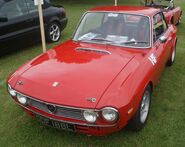
1972 Lancia Fulvia Sport S
The Lancia Fulvia was the successor to the Appia and took over its place in 1963.
The Fulvia came in sedan, coupe, and "sport" versions, with the third being a rebodied coupe styled by Zagato. Unlike the earlier Appia which was rear-wheel drive, the Fulvias were front-wheel drive. The new drivetrain combined with disc brakes, front independent suspension, and Lancia's new narrow-angle V-4 engine helped the Fulvia become a successful rally car and it went on to win the International Rally Championship in 1972.
The Fulvia's triumph in the world of rally racing established Lancia as a power in the sport and led to the company building their own dedicated rally car, the Lancia Stratos.
Chassis[]
The Fulvia Berlina was designed by Antonio Fessia, to replace the Lancia Appia with which it shared almost no components. The Appia was a rear wheel drive car, however, while the Fulvia moved to front wheel drive like the Flavia. The general engineering design of the Fulvia was identical to that of the Flavia with the major exception of the engine, the Flavia having a four cylinder horizontally opposed engine and the Fulvia a 'Narrow Angle' vee configuration as featured on most production Lancias from the Lambda. The Fulvia used a longitudinal engine mounted in front of its transaxle. An independent suspension in front used wishbones and a single leaf spring, while a beam axle with a panhard rod and leaf springs was used in back. Four wheel Dunlop disc brakes were fitted to 1st series Fulvias. With the introduction of the 2nd Series in 1970 the brakes were uprated with larger Girling calipers all round and a brake servo. The handbrake design was also changed - using separate drums and brake-shoes operating on the rear wheels.
Engine[]
One element that was new was the narrow-angle V4 engine. Designed by Zaccone Mina, it used a narrow angle (12°53'28") and was mounted well forward at a 45° angle. The engine is a DOHC design with a one camshaft operating all intake valves and another operating all exhaust valves. The very narrow angle of the cylinders allowed for use of a single cylinder head.
Displacement began at just 1091 cc with 58 bhp (44 kW) with a 72 mm bore and 67 mm stroke. A higher (9.0:1) compression ratio and the fitment of twin Solex carburettors raised power to 71 bhp (53 kW) soon after.
The engine was bored to 6 mm to enlarge displacement to 1216 cc for the HF model. This, and some tuning, raised output to 80 to 88 bhp (60 to 66 kW).
The engine was re-engineered with a slightly narrower bank angle (12°45'28") and longer (69.7 mm) stroke for 1967. Three displacements were produced: 1199 cc (74 mm bore), 1231 cc (75 mm bore), and 1298 cc (77 mm bore). The new 1298 cc engine was produced in two versions; the type 818.302 produced 87 bhp (65 kW) at 6000 rpm and was fitted to 1st series Coupes, Sports and Berlina GTE and later to the 2nd Series Berlina. The Type 818.303 was first produced with 92 hp (69 kW) and was fitted to the 1st series Coupe Rallye S and Sport S. For the 2nd Series Coupe and Sport power was slightly reduced to 90 hp (67 kW) at 6000 rpm. The 1199 cc engine was only fitted to the Berlina sold in Greece.
The engine was completely reworked for the new 1.6 HF with an even-narrower angle (11°20' now) and longer 75 mm stroke combined with a bore of 82 mm gave it a displacement of 1584 cc, and power ranged from 115 to 132 bhp (85 to 98 kW) depending on tune.








